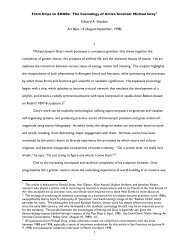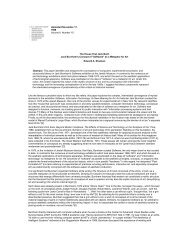Cybernetics and Art: Cultural Convergence in the ... - Edward Shanken
Cybernetics and Art: Cultural Convergence in the ... - Edward Shanken
Cybernetics and Art: Cultural Convergence in the ... - Edward Shanken
Create successful ePaper yourself
Turn your PDF publications into a flip-book with our unique Google optimized e-Paper software.
system that regulated <strong>the</strong>ir artistic behavior as an <strong>in</strong>tegrated whole.For example, as Ascott himself expla<strong>in</strong>ed, form<strong>in</strong>g groups of six, eachstudent would be “set <strong>the</strong> task of acquir<strong>in</strong>g <strong>and</strong> act<strong>in</strong>g out . . . a totallynew personality, which is to be narrowly limited <strong>and</strong> largely <strong>the</strong>converse of what is considered to be <strong>the</strong>ir normal ‘selves.’” 32 Astudent’s preconceptions about his or her personality, strengths <strong>and</strong>weaknesses as an artist, <strong>and</strong> about <strong>the</strong> nature of art itself, were notonly thrown <strong>in</strong>to question, but were actively transcended through <strong>the</strong>forced adoption of different behavioral characteristics <strong>and</strong> a reth<strong>in</strong>k<strong>in</strong>gof art-mak<strong>in</strong>g <strong>and</strong> art as process <strong>and</strong> system. Because <strong>the</strong>ir <strong>in</strong>dividualbehaviors had to be <strong>in</strong>tegrated <strong>in</strong>to a coherent group process, eachmember would be “of necessity <strong>in</strong>terdependent <strong>and</strong> highly consciousof each o<strong>the</strong>r’s capabilities <strong>and</strong> limitations” <strong>in</strong> order to accomplishtoge<strong>the</strong>r <strong>the</strong> “set goal of produc<strong>in</strong>g . . . an ordered entity.” 33 In thisway, students learned about <strong>the</strong> pr<strong>in</strong>ciples of cybernetics as applied toart through <strong>the</strong>ir own behavioral <strong>in</strong>teractions as part of a cyberneticart system <strong>in</strong> which <strong>the</strong> controlled exchange of <strong>in</strong>formation organized<strong>the</strong> overall structure.British composer Brian Eno, who was a student of Ascott’s atIpswich <strong>in</strong> 1964-66, offered a first-h<strong>and</strong> account of his teacher’spedagogical methods, <strong>and</strong> <strong>the</strong>ir impact on him:One procedure employed by Ascott <strong>and</strong> his staff was <strong>the</strong>“m<strong>in</strong>dmap.” In this project each student had to <strong>in</strong>vent a gamethat would test <strong>and</strong> evaluate <strong>the</strong> responses of <strong>the</strong> people whoplayed it. All <strong>the</strong> students <strong>the</strong>n played all of <strong>the</strong> games, <strong>and</strong><strong>the</strong> results for each student were compiled <strong>in</strong> <strong>the</strong> form of achart—or m<strong>in</strong>dmap. The m<strong>in</strong>dmap showed how a studenttended to behave <strong>in</strong> <strong>the</strong> company of o<strong>the</strong>r students <strong>and</strong> howhe reacted to novel situations. In <strong>the</strong> next project eachstudent produced ano<strong>the</strong>r m<strong>in</strong>dmap for himself that was <strong>the</strong>exact opposite of <strong>the</strong> orig<strong>in</strong>al. For <strong>the</strong> rema<strong>in</strong>der of <strong>the</strong> termhe had to behave accord<strong>in</strong>g to this alternative vision ofhimself. 34Eno fur<strong>the</strong>r noted: “For everybody concerned this . . . extraord<strong>in</strong>aryexperience . . . was <strong>in</strong>strumental <strong>in</strong> modify<strong>in</strong>g <strong>and</strong> exp<strong>and</strong><strong>in</strong>g <strong>the</strong> rangeof <strong>in</strong>teraction each student was capable of.” 35Moreover, <strong>in</strong> Ascott’s Groundcourse, students were<strong>in</strong>troduced to o<strong>the</strong>r experimental artists <strong>and</strong> <strong>in</strong>tellectuals <strong>in</strong> a varietyof discipl<strong>in</strong>es. One powerful example of <strong>the</strong> <strong>in</strong>fluence of this guestlecture program is <strong>the</strong> impact on <strong>the</strong> young British musician PeterTownshend of artist <strong>and</strong> holocaust survivor Gustav Metzger’spresentation on destruction <strong>in</strong> art. Townshend, who would laterform <strong>the</strong> rock b<strong>and</strong>, The Who, has credited Metzger’s <strong>the</strong>ory withgiv<strong>in</strong>g him <strong>the</strong> idea to destroy musical <strong>in</strong>struments onstage at Whoconcert performances—a performative gesture that visuallysymbolized <strong>the</strong> anger <strong>and</strong> rebellion of a generation. 36 Stiles has<strong>the</strong>orized this transference of ideas from Metzger to Townshend asan example of <strong>the</strong> process by which <strong>the</strong> most advanced conceptualdevelopments <strong>in</strong> experimental visual art are transmitted <strong>in</strong> <strong>in</strong>sidiousways to become <strong>in</strong>corporated <strong>in</strong>to popular culture. 37 Such a <strong>the</strong>oryof <strong>the</strong> operations of art <strong>in</strong> culture offers a model for underst<strong>and</strong><strong>in</strong>ghow Ascott’s cybernetic conception of art entered <strong>in</strong>to <strong>the</strong> popularimag<strong>in</strong>ation.12





